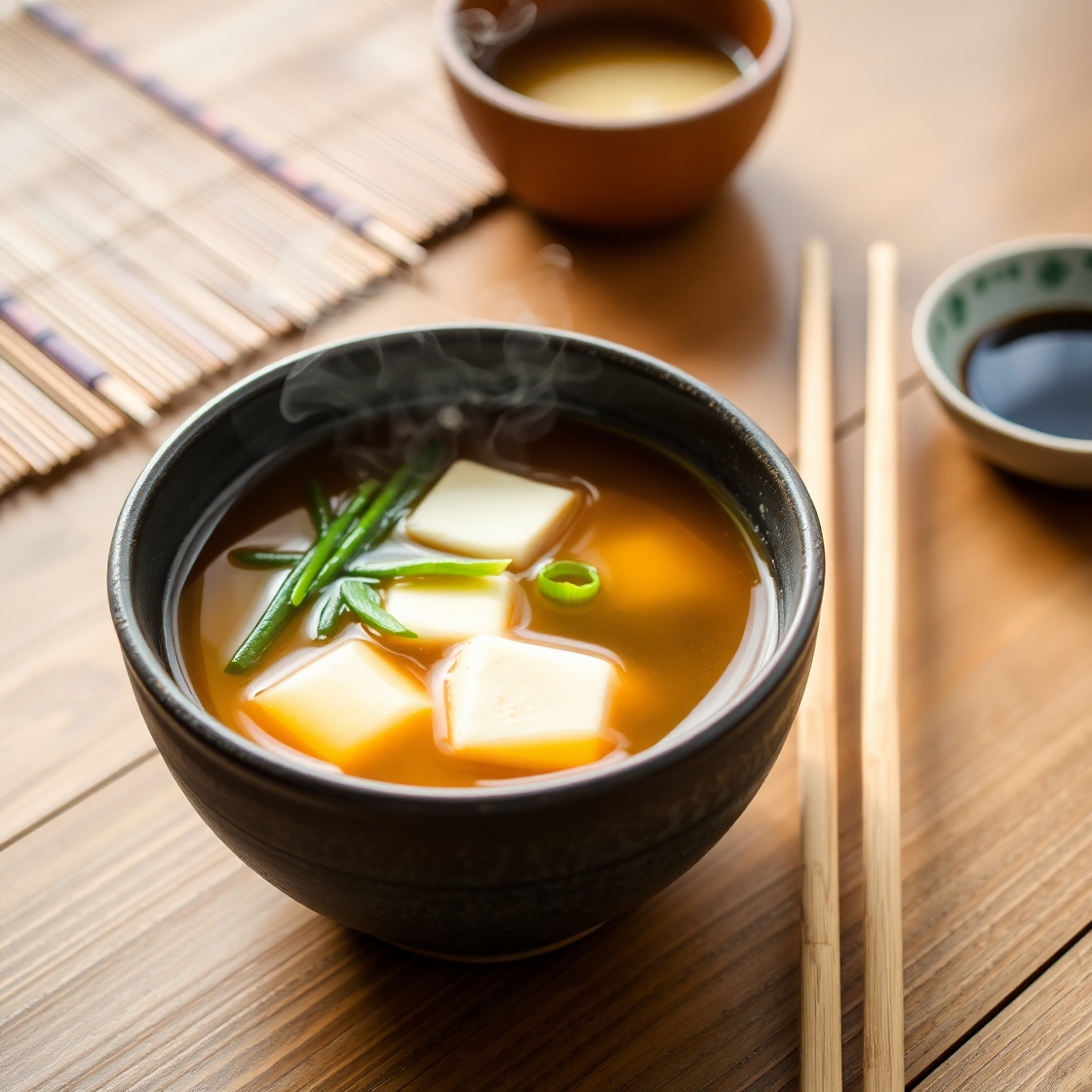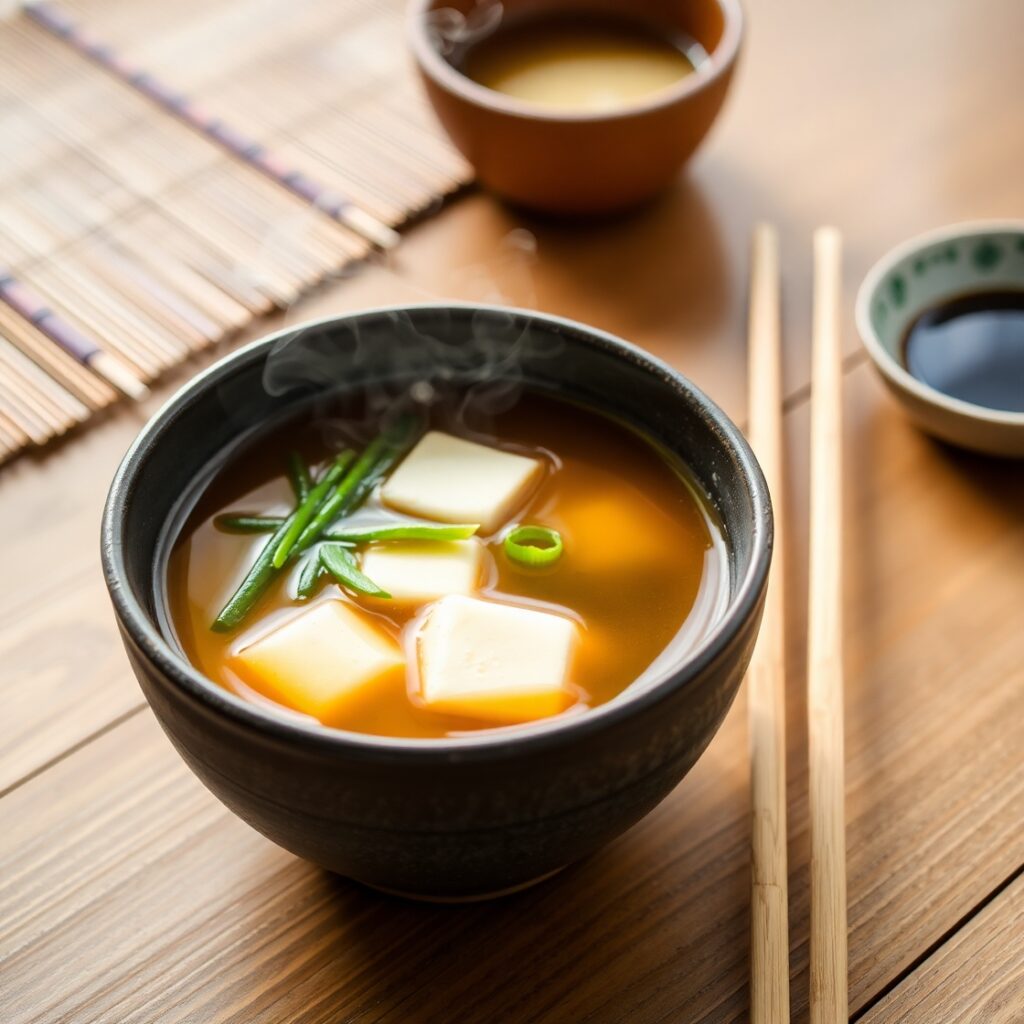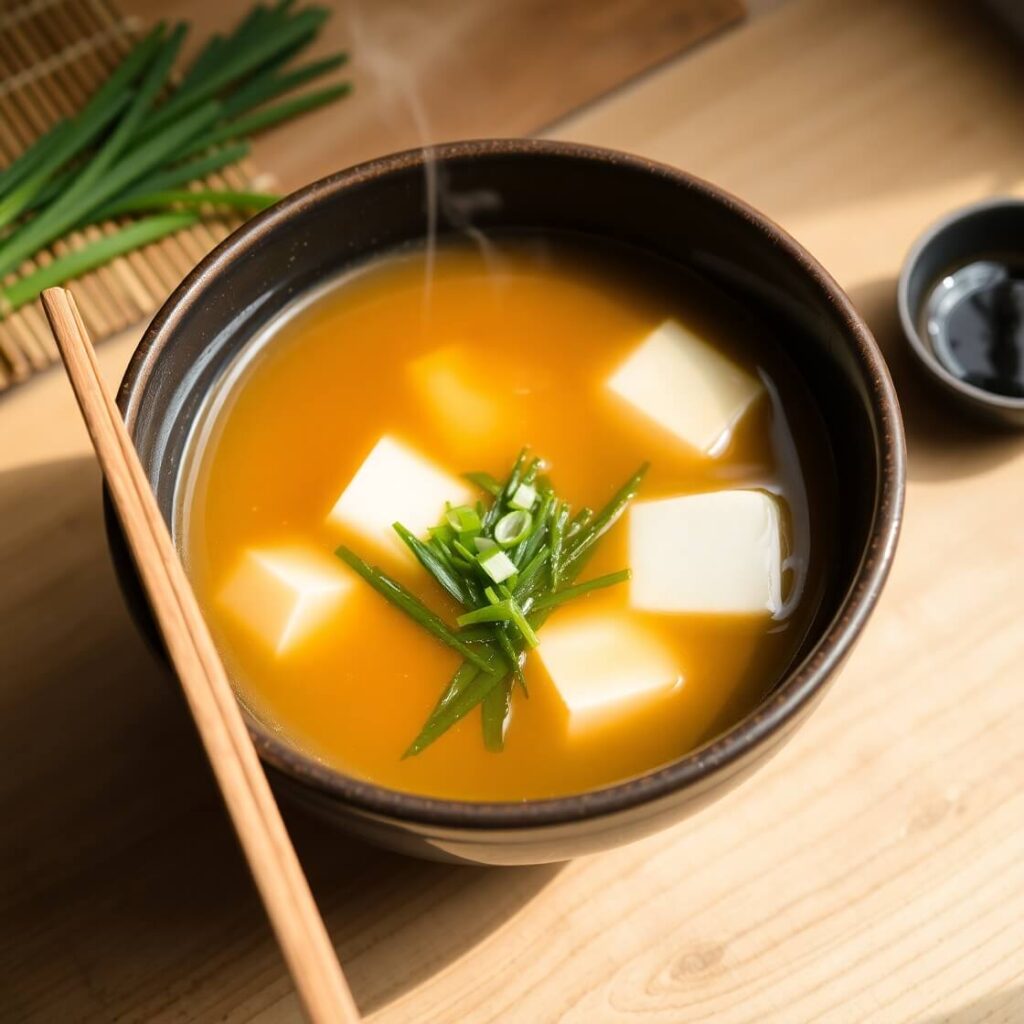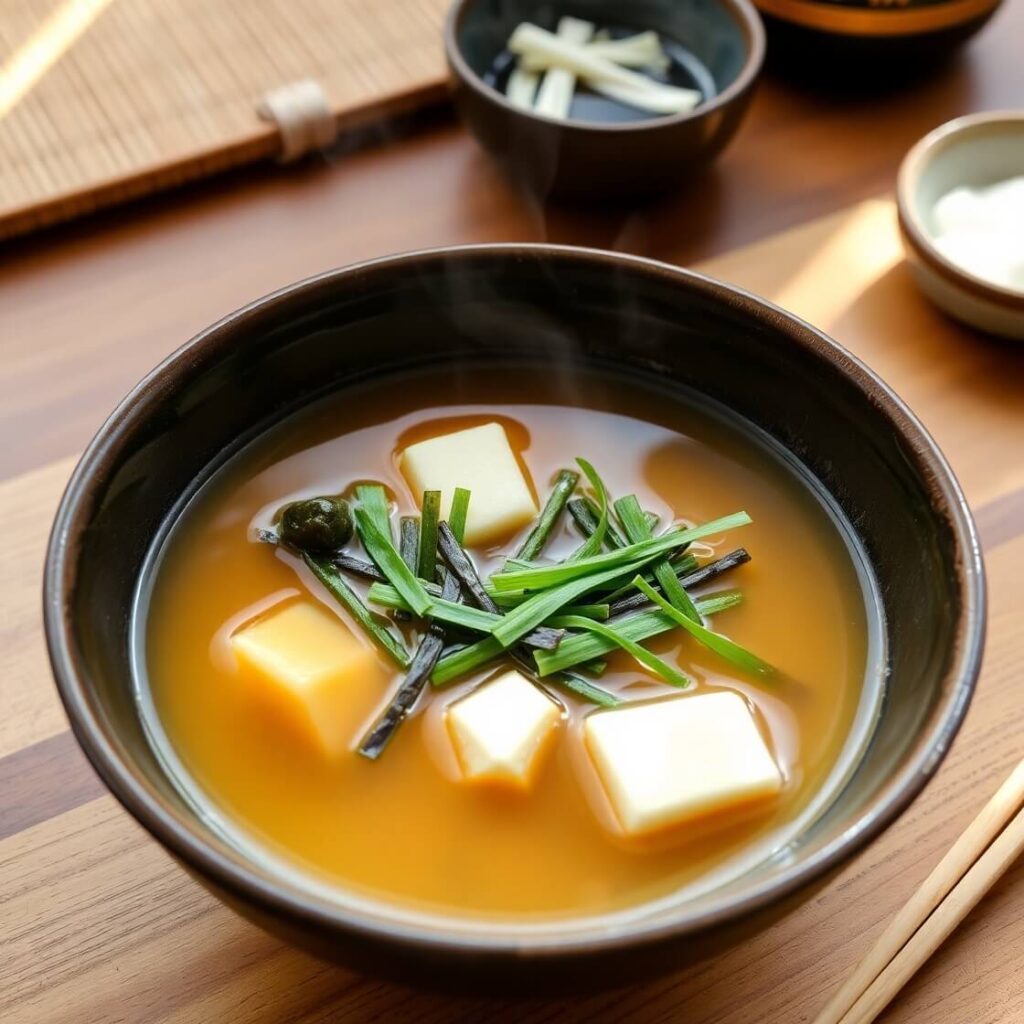Homemade Miso Soup Recipe

I’ll never forget the first time I tried miso soup. It wasn’t in a fancy restaurant or during an exotic trip abroad—it was in my own kitchen, armed with a packet of instant miso paste and an ambitious sense of culinary curiosity. I remember simmering the dashi stock and feeling the faint aroma of seaweed fill the room. The soup wasn’t perfect—the tofu pieces were a little large, and I accidentally stirred too vigorously, creating a foamy mess—but the flavor, warm and umami-rich, reminded me of quiet evenings spent with family. From that moment on, miso soup became my go-to comfort dish, something I’d whip up when I wanted a quiet pause in the middle of a busy week.
Over time, I learned that the magic of miso soup lies not in complexity, but in balance—each ingredient contributes to a delicate harmony that’s soothing, yet layered with flavor. It’s the kind of recipe that makes you slow down, pay attention to the subtle notes, and savor the process as much as the result.
The Essentials for This Dish
Miso soup feels simple, but the ingredients are surprisingly flexible, and choosing them thoughtfully makes all the difference.
- Miso paste: The star of the show. White miso is sweeter and milder, perfect for beginners, while red miso gives a deeper, more robust flavor. I often keep both on hand and mix a small spoonful of red miso into white miso for an extra depth.
- Dashi stock: Traditional miso soup relies on dashi, a Japanese stock made from kombu (kelp) and bonito flakes. For a vegetarian version, a kombu and shiitake base works beautifully. I sometimes make a batch and freeze it in small portions—it makes a weeknight soup feel gourmet.
- Tofu: Silken or soft tofu adds a creamy texture without overpowering the soup. I cut mine into small cubes so every spoonful has a balance of miso, tofu, and broth.
- Seaweed: Wakame is classic. Dried sheets plump quickly in hot liquid, adding color and a subtle brininess.
- Optional vegetables: Thinly sliced mushrooms, green onions, or baby spinach add freshness and texture. I once added shredded carrots for color—it wasn’t traditional, but it made my kids smile.
When I shop for these ingredients, I like to peek at Japanese markets or the international aisle of my local grocery store. Freshness matters—especially for miso paste. A good-quality miso paste will smell fragrant and earthy, not sour or overly salty.
The Flavor Balance
Miso soup is deceptively simple, yet the flavor profile is layered and nuanced.
- Umami: This is the backbone—the savory depth that makes miso soup comforting. Kombu and miso paste work together to create this.
- Saltiness: Miso provides natural salt, so you rarely need extra. Taste before adding anything more; over-salting is a common mistake I made early on.
- Sweetness and Earthiness: White miso leans sweet, while tofu and vegetables bring an earthy undertone.
- Texture contrast: Soft tofu, tender wakame, and sometimes crisp green onions make each spoonful feel dynamic.
The trick is subtlety—avoid boiling the miso paste vigorously or it can become grainy and lose its delicate aroma. I learned this the hard way the first time I impatiently dumped my paste into rolling water. Now, I whisk it in gently off the heat, letting the warmth dissolve it evenly.
My Cooking Process

- Prepare the dashi stock: In a medium saucepan, combine 4 cups of water with a piece of kombu. Let it soak for 30 minutes if you have time, then gently bring to a simmer. Remove the kombu just before the water boils. Sprinkle in a handful of bonito flakes if using, simmer for 2 minutes, then strain.
- Prepare tofu and seaweed: Cut ½ block of silken tofu into small cubes. Rehydrate a tablespoon of dried wakame in water for a few minutes and drain.
- Incorporate the miso: Remove the dashi from heat. In a small bowl, mix 3 tablespoons of miso paste with a ladle of warm dashi until smooth, then stir it back into the pot. Avoid boiling at this stage.
- Add tofu and wakame: Gently stir in tofu cubes and wakame, letting them warm through.
- Optional garnishes: Thinly sliced green onions or a few mushrooms add texture and color. Serve immediately.
The first time I followed these steps, the aroma alone made me pause—the gentle scent of seaweed, the creamy miso, the earthy tofu—it felt like a hug in a bowl.
Serving Tips for Maximum Comfort

Miso soup is comforting on its own, but there are little touches that elevate it into a full experience. I like to serve it in small, heat-retaining bowls with a side of steamed rice or a light salad. A few slivers of fresh green onion on top add a burst of color and freshness, while a sprinkle of sesame seeds gives a subtle nuttiness that complements the umami depth.
For family meals, I often place a small tray of condiments nearby—soy sauce, a pinch of chili flakes, or even a dash of yuzu juice. Everyone can customize their bowl, making the soup interactive and fun. And if you’re entertaining, pair it with sushi, tempura, or a simple noodle dish—the mild flavor of the miso balances richer, heavier flavors beautifully.
Pro Notes & Mistakes to Avoid
Over the years, I’ve learned a few things that make miso soup truly shine:
- Never boil the miso paste: High heat destroys the delicate flavor and can make the paste grainy. Always stir it in off the heat.
- Cut tofu carefully: Large chunks can break apart in the pot. Small, uniform cubes keep the soup elegant and easy to serve.
- Rehydrate wakame properly: A quick soak in water is enough. Too long, and it becomes slimy; too short, and it stays tough.
- Taste before serving: Different miso brands vary in saltiness. Adjust gently, adding more miso or a tiny splash of soy sauce if needed.
I remember one night rushing to make soup for guests. I boiled the miso, thinking it would dissolve faster. The flavor flattened completely, and I had to start over. From that day on, I never ignore gentle stirring—it’s a small step that makes a huge difference.
Storage & Make-Ahead Tips
Miso soup is best enjoyed fresh, but you can make a few adjustments if you want to prepare ahead:
- Dashi stock: Make a large batch and refrigerate for up to 5 days or freeze in small portions for up to a month.
- Soup assembly: Keep miso paste, tofu, and wakame separate until just before serving. Mixing too early can affect texture.
- Reheating: Warm gently on the stove; avoid microwaving at high heat, which can alter the delicate flavors.
These tips help maintain the light, fresh taste that makes miso soup so comforting, even if you’re meal-prepping for the week.
FAQs About Miso Soup
Can I make miso soup without dashi?
Yes, you can substitute vegetable broth or water, but the flavor won’t be as rich. Adding dried shiitake mushrooms helps boost umami.
Is miso soup healthy?
Absolutely. It’s low in calories, rich in probiotics (if the miso is unpasteurized), and contains protein from tofu and minerals from seaweed.
Can I freeze miso soup?
I don’t recommend freezing fully prepared soup with miso paste—it can affect texture and flavor. Freeze the stock separately if needed.
How long does miso soup last in the fridge?
Once combined, it’s best within 24 hours. Tofu can start to break down and miso flavor may intensify over time.
Can I add other vegetables?
Yes! Thinly sliced mushrooms, spinach, or even shredded carrots work well. Just add them near the end of cooking to keep them tender.

Miso Soup Recipe
- Total Time: 20 minutes
- Yield: 4 1x
- Diet: Vegetarian
Description
A timeless Japanese classic, miso soup is a comforting and nourishing dish that combines the rich umami flavor of fermented miso paste with delicate dashi broth, soft tofu, and seaweed. This simple soup is not only quick to prepare but also packed with probiotics and essential nutrients. Perfect as a starter or light meal, miso soup brings warmth and wellness to your table with every spoonful.
Ingredients
- 4 cups dashi broth (homemade or instant)
- 3 tablespoons white miso paste
- 1/2 cup silken tofu, cut into small cubes
- 1 tablespoon dried wakame seaweed, soaked and drained
- 2 green onions, thinly sliced
Instructions
- Prepare dashi broth by soaking kombu and simmering with bonito flakes or use instant dashi.
- Soak wakame seaweed in water for 5 minutes, then drain.
- Bring dashi broth to a gentle simmer, avoid boiling.
- Dissolve miso paste in a small bowl with some warm broth, then stir back into the pot.
- Add tofu cubes and wakame, gently warm for 1–2 minutes without boiling.
- Remove from heat, garnish with green onions, and serve immediately.
Notes
- Avoid boiling after adding miso to preserve flavor and probiotics.
- Adjust miso quantity to taste, especially if using saltier varieties.
- For a vegan version, use kombu-only dashi or mushroom broth.
- Prep Time: 5 minutes
- Cook Time: 15 minutes
- Category: Soup
- Method: Stove-top simmering
- Cuisine: Japanese
Nutrition
- Serving Size: 4
- Calories: 70
- Sugar: 1g
- Sodium: 750mg
- Fat: 2g
- Saturated Fat: 0.3g
- Unsaturated Fat: 1.5g
- Trans Fat: 0g
- Carbohydrates: 7g
- Fiber: 1g
- Protein: 6g
- Cholesterol: 0mg







